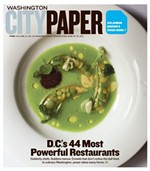Just Skidding
Historically, The Fast and the Furious movies have had a certain visceral appeal: Cars go fast, wheee! Hot chicks drop trou at the sight of 4-inch pistons, whooo! The third installment, The Fast and the Furious: Tokyo Drift, can’t achieve even that. But worse, it violates the axiom that a movie with all the intellectual rigor of a Hot Wheels commercial or a Street Low issue should at least feature charismatic stars. We’ve gone from Paul Walker and Vin Diesel in the original, to Walker and crooner/actor Tyrese Gibson in 2 Fast 2 Furious, to Sling Blade kid Lucas Black and rapper/actor Bow Wow. At this rate, the inevitable fourth film will star Frankie Muniz and Raven-Symoné. The actors can’t be blamed, though, for the cars’ lack of get up and go. If you thought that transporting the movies’ trademark nitrous-oxide canisters and kandy-kolored coupes to Tokyo would result in pedestrian-threatening pursuits down densely packed, neon-illuminated streets, think again. Instead, the film’s “drift” races take place mostly in depopulated parking garages where it’s hard to build up a decent head of steam, much less clip passers-by. What’s drifting? As troublemaking, drawltastic Alabaman racing junkie Sean (Black) discovers, it’s pretty much like regular driving—only with more skids and more sluttily dressed women. Sent to Japan to live with his estranged father after a series of vehicular mishaps, Sean learns the ropes of the fer-uhn racing scene as he gets acclimated to his new hometown. Tokyo, of course, turns out to be bursting with cell-phone-camera-toting teens, pachinko parlors, and lipstick-lesbian-friendly nightclubs attached to gigantic garages full of swanky rides driven by yakuza-affiliated hipsters. No one should expect Tokyo Drift to offer a penetrating view of modern Japanese life, but it’s still disappointing that director Justin Lin does nothing to undercut his scripters’ flimsy clichés. Lin’s directorial debut, 2002’s engaging if uneven Better Luck Tomorrow, showed how a group of Asian-American high-schoolers could get away with murder by taking advantage of the stereotype that all Asians are “good kids.” His latest takes a gaijin or three—let’s not forget Sean’s American sidekick (Bow Wow) or his Australian love interest (Nathalie Kelley)—drops them into a strange city and a bizarre subculture, and then gives us a predictably quick-cut lesson in how self-possessed Westerners can overcome anything. Visceral appeal? Not from a filmmaker who’s left his guts behind.

